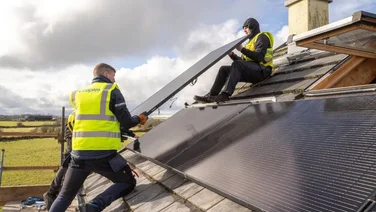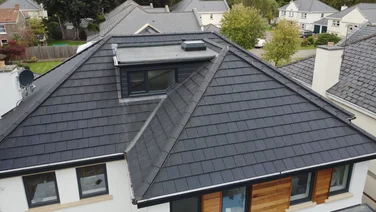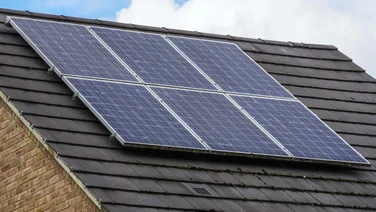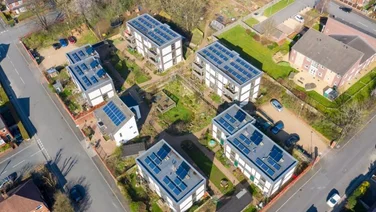✔ Most commercially available ‘transparent solar panels’ are 30-40% transparent
✔ Scientists in Michigan have developed solar panels with 86% transparency
✔ Transparent solar panels have an average efficiency of 1% to 10%
The benefits of solar panels of all types are clear – they’re good for the planet, can save homeowners money on electricity bills.
You will have noticed that standard solar panels are opaque, or in other words you can’t see through them. That’s because solar panels are trying to capture visible light in order to generate power, so it’d be useless if they were see-through.
Well, clever scientists around the world have spotted a window of opportunity; transparent solar panels. That’s right – panes of glass that can convert the sun’s light into energy, without being nearly as obvious as traditional solar panels.
The potential number of uses for transparent solar panels is dizzying – think skyscrapers, train stations, greenhouses, phone screens – but it’s still relatively early days. Read on to get the full lowdown.
Where do you want to install solar panels?
Get started
What is a transparent solar panel?
It’s fairly self-explanatory: a transparent solar panel is a see-through solar panel, typically made of glass. Its sleek, subtle appearance makes it ideal for use in place of standard glass, which makes it a prime example of ‘building-integrated photovoltaics’ (BIPV).
In contrast, traditional solar panels (which usually come in black or blue) are extremely noticeable, and are usually placed on top of a building, as opposed to being built into it. Some people reckon that solar panels look ugly, so transparent solar panels offer a solution to this aesthetic problem.
But these aesthetic benefits come at a cost, with transparent panels costing much more than standard ones. Want to learn more? Head to our solar panel cost page.
And considering 69% of people are already likely or very likely to buy or rent a property with solar panels according to our latest National Home Energy Survey, this superior model of panel should prove even more popular.
How ‘transparent’ are they?
The term ‘transparent solar panel’ can be a little misleading.
You could have a solar panel that is slightly see-through and a solar panel that is completely see-through, and they’d both technically be ‘transparent solar panels’. This seems a little unfair on the crystal-clear panel to lump it in with the murky one.
However, transparency is a spectrum, typically expressed as a percentage. If a company produces solar panels with 30% transparency, you won’t be able to see out of them with perfect clarity, but they are transparent solar panels nonetheless.
You might be disappointed to know that nobody has yet created a solar panel with 100% transparency. Some smart folk in Michigan are working on it (we’ll get on to that), but the market is largely dominated by panels with 30-40% transparency.
So, in terms of transparent solar panels that are actually commercially available, don’t think “clear water”, think “water that’s a little bit muddy” – at least for the time being.
What are transparent solar panels used for?
Transparent solar panels can be used as canopies, facades, skylights, curtain walls, greenhouses and more. They are usually used in the place of, or alongside regular glass structures.
Here are some of the places you’ll find PolySolar’s see-through panels doing their thing.
- The roof of a cycle shelter in Cambridge North train station. The roof of the shelter is composed of 196 panels (250W each), which generate around 10% of the station’s required power.
- A bus stop in Canary Wharf, London. Opened in April 2016 and located just outside the HSBC building, this grey-tinted structure can create up to 2,000 kilowatt hours (kWh) per year, and is used to power nearby smart signs and infrastructure.
- A curtain wall for Gloucestershire County’s Council Hall. Completed in 2018, this project can reportedly save 9.5 tonnes of carbon dioxide (CO2) per year.
- The roof of a transport hub at Bournemouth University. The 16.4 kW system is made of 20% transparent solar panels, and provides both light and shading.
Other examples include a canopy outside the Barbican Theatre in London, a Sainsburys forecourt in Bishops Waltham, and an outdoor swimming pool solarium in Hathersage Lido. Want to see how panels can be paired with a pool? Check out our helpful guide: The Complete Guide to Solar Panels for Swimming Pools.
Naturally, most of these installations feature solar panels with just 30-40% transparency, but it shouldn’t be too long before transparent solar panel installations are essentially unnoticeable.
Where do you want to install solar panels?
Get startedHow much do transparent solar panels cost?
Transparent solar panels cost around £250 per square metre. So far, they have mainly been sold in commercial contexts, although some transparent solar panel canopies can be purchased for domestic garden use.
So while it certainly isn’t the norm for households to be installing transparent solar panels, the era of residential see-through panels is just around the corner.
In the long term, it’s expected that transparent solar panel installations will be around 50% cheaper than standard installations, mainly because buildings will be able to stick with their existing window frames and panes of glass.
The pros and cons of transparent solar panels
- Discreet appearance, can be used in place of glass
- Let natural light into buildings
- Cut down on glare by acting as a partial sun shade
- Cost around half as much to produce than traditional solar panels
- Organic solar cells degrade over time
- Around half as efficient as regular solar panels, at best
- Not fully transparent: 30%-40% transparent on average
- Technology is still very new, only around 10 years old
Should you get transparent solar panels?
You should only get transparent solar panels to use as a replacement for glass in large scale commercial or public buildings. In fact, most transparent solar panels are only available for these types of projects.
At their current levels of efficiency, they are not worth it in most domestic settings. At best, they’ll only produce half the amount of electricity as regular solar panels, meaning that a typical household won’t see a return on investment during the 25 year lifespan of the panels.
And remember, the more see-through transparent solar panels are, the less efficient they’ll be. So replacing windows in a house with 70% transparent solar panels, with average efficiency of 1% to 5%, isn’t going to produce much electricity.
So far, the most viable way to use transparent solar in a domestic context is to use them as part of a greenhouse, and power the greenhouse lights and watering system with them.
There are other ways you can make your greenhouse more eco-friendly – and adding double glazing is an excellent place to start. You can learn more about this on our page: The Complete Guide to Double Glazed Greenhouses.
But if scientists manage to develop transparent solar panels that are just as efficient as regular solar panels, they could become a viable option for private homeowners.
The best transparent solar panels
So which companies are at the cutting edge of glass solar panels? Here are five big players worth knowing about.
Polysolar
Founded in 2007, Polysolar has been designing and manufacturing transparent solar panels in Cambridge, UK for over a decade. Its panels aren’t more than 30-40% transparent, but they’ve been popping up all over the country (as discussed above).
Ubiquitous Energy
While the California-based Ubiquitous Energy might not yet have many real transparent solar panel installations to its name, it does have ambitious plans. The company was founded in 2011 by Richard Lunt – one of the MSU researchers who created the panel with 86% transparency – and its TLSC technology (now patented as ClearView Power™) is about to shake up the industry.
In May 2019, it was announced that Ubiquitous Energy is partnering with global glass manufacturer NSG Group to start integrating ClearView Power™ into architectural window glass.
Onyx Solar
Onyx Solar is all about scale. It has offices in three continents, its 4x2m PV glass is the largest available on the market, and the company has undertaken more than 250 projects so far, with big-name clients including Samsung, Apple, Coca-Cola, and Heineken. Its solar panels offer just 30% transparency, but this is pretty much the industry standard.
Physee
Dutch firm Physee’s transparent solar panel technology (PowerWindows™) has been implemented on numerous corporate buildings across the Netherlands, and it looks lovely. Install enough of Physee’s PowerWindows™ and you have yourself a Physee SmartSkin™, which might need a different name. Check out the absolutely gorgeous Physee website for an idea of what the company’s panels can do.
Heliatek GmbH
Based in Germany, Heliatek was given a Technology Pioneer award in 2015. Its patented Heliafilm™ technology allows for solar panels with customisable levels of transparency reaching up to 40%. Heliatek completed an installation in Spring 2015 that gave Europe its first solar concrete wall, located in Herne, Germany.
Brite Solar
Founded in Greece in 2009, Brite Solar develops transparent solar panels which they call “solar glass”. Their products are 49% to 70% transparent, but so far only 5% efficient. Brite Solar’s solar glass is designed to be used in and power agricultural greenhouses.
How are transparent solar panels made?
The processes for creating partially transparent solar panels and fully transparent solar panels are rather different, so we’ll go into both.
Partially transparent solar panels
If you’re somewhat familiar with traditional solar panels, you might know that they use hefty wafers of ‘monocrystalline’ or ‘polycrystalline’ silicon.
When it comes to transparent solar panels, the process is very different. Manufacturers use a technology called thin-film photovoltaics (TPVs), which basically involves pasting ultra thin layers of semiconductor material (usually cadmium telluride) on a sheet of glass. They then stick another sheet of glass on top, to create a kind of cadmium telluride sandwich.
By ‘ultra thin layers’, we really do mean ultra thin. It’s usually nothing more than a few microns (i.e. a few millionths of a meter). This is what enables the glass to remain fairly transparent, because each layer of the semiconductor material causes only a slight increase in opacity.
Thin-film solar panels typically achieve an efficiency of approximately 7-10%. This percentage refers to the proportion of sunlight hitting the panel that is then converted into usable energy.
However, there’s a price to pay for transparency; standard monocrystalline solar panels have efficiencies of over 20%, with some premium models hitting 25%.
UK-based Polysolar have engineered a grey-tinted thin-film solar panel that has 12-15% efficiency, but it’ll be a while before thin-film manufacturers are competing with the old guard.
Organic solar cells can also be used to create semi-transparent solar panels. Go to our page to find out more.
Fully transparent solar panels
To create a solar panel that actually resembled normal glass, researchers at Michigan State University essentially had to rethink how solar photovoltaic technology worked. And they did a pretty good job.
Here’s the problem: standard solar panels capture visible light and convert it into power, but a truly transparent material would let all the visible light through. The answer? Capture all the light we can’t see.
The researchers created a transparent luminescent solar concentrator (TLSC), which consists of organic salts designed to absorb non-visible wavelengths of light, specifically ultraviolet and infrared.
All of this light is transformed into a different kind of infrared and moved to the edges of the pane, where small strips of traditional solar cells convert it into electricity.
Their solar panel boasts a mighty 86% transparency, but a measly 1% efficiency – there’s a long way to go.
Does it matter if they’re not efficient?
The poor efficiency of transparent solar panels is certainly a negative – especially when you compare it to the best solar panels on the market – but it’s not actually a major problem.
If a building has limited space for traditional solar panels, then efficiency becomes a very important consideration. However, if you’re replacing every window on the side of a building with a transparent solar panel, the individual performance of each panel becomes less of an issue.
For example, a huge corporate building in the city centre might have 20 square metres of monocrystalline solar panels, each with 20% efficiency. If they replaced this with 40 square metres of transparent solar panels on an external wall, each with 10% efficiency, then the energy production would be the same, and the building’s appearance would be vastly improved.
We agree, it’s a bit of a weird one. Generally speaking, the more transparent the solar panel, the worse its efficiency – but the more transparent the solar panel, the greater its number of potential uses.
Next Steps
The future of solar energy belongs to the transparent solar panel – it’s just a question of when it’ll make its claim. Smart folk the world over are working hard to engineer the perfectly clear, high-efficiency panel, and with new solar panel technologies coming on leaps and bounds, hopefully it won’t be long before they’re available for businesses and households alike.
In other news, standard solar panels are still in top spot. If you’d like to make the switch to solar, simply fill in this short form, and our professional installers will be in touch with quotes tailored to you.






